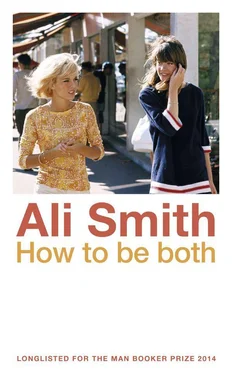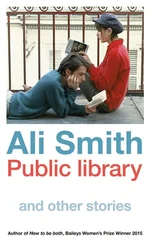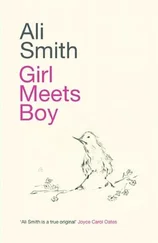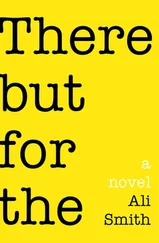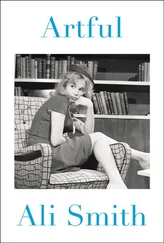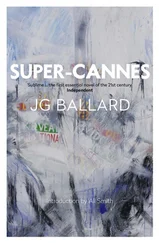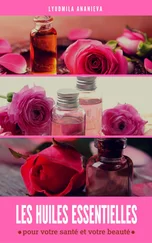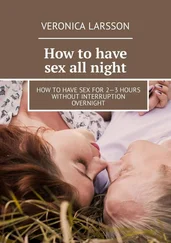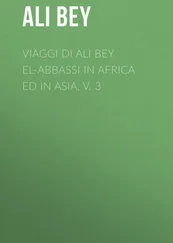Art makes nothing happen in a way that makes something happen. (That’s the wording of one of her mother’s most retweeted Subverts.) Obviously. But this is a family game. They’ve played this game for years. It is one of her father’s games, he plays it to make her and her brother laugh whenever her mother makes them all go to a gallery. He pretends to be a slightly mentally challenged person. He pretends it so well that sometimes people in the galleries turn and look at him, or look away in case he really might be mentally challenged.
In this case the art in this room has already made something happen — the literal cheering-up of her mother, who happened last week to see a stray photo in an art magazine of one of the pictures from here, a blue-coloured picture of a man standing dressed in ripped white clothes and wearing an old rope as a belt, at the seeing and liking so much of which her mother literally stopped being sad (she has been in a bad mood for weeks now because of her friend Lisa Goliard disappearing) then announced to the family over breakfast three days ago that they were all going to see that picture for real next week and that she’d booked a hotel.
Nathan, can you take Wednesday to Sunday off? she said.
Nope, her father said.
Fine, she said. I don’t need you to look at pictures with me. George, can you take Wednesday to Friday off school?
I’ll have to check with my secretary, George said, I’ve got a very busy schedule. And I feel it’s my duty to inform you that it’s illegal to take children out of school just for holidays now.
How’s your throat? her mother said.
Really really sore, George said. I think it’s an infection. Where are we going?
Somewhere in Italy, her mother said. Henry, how’s your throat?
My throat is very well, thank you for asking, Henry said.
Henry, your throat is really sore, George said.
Is it? Henry said.
Otherwise you can’t come to Italy, George said.
Is it good there for throats? Henry said.
Now, in the palazzo, when George says the supposed-to-be-funny thing about what’s the point of art, Henry says, as if he thinks she means it too,
It’s really pretty.
Henry is gay. He must be. Though it’s true, this is a really pretty room. At least, that part up at that end there is, it’s spectacular, or maybe it’s just better lit than the other parts of the room. Her mother is off the whole length of the place towards it. It is like her mother has been struck by — what? Lightening. Her mother has lightened up since the minute they landed in this country and the plane door opened and the warmer air came in.
The moment they walked into this room she lightened even more.
Though it is embarrassing and excruciating when someone won’t play your game George gets over herself. She slips into her real self again.
Is this the place you were talking about in the car? she says. The moral conundrum?
Her mother says nothing.
She is looking.
George looks too.
The room is warm and dark. No, not dark, it’s light. Both. It’s like a huge dark dance hall with a lit-up picture that goes round some of its walls. There is nothing else in the room, except some low benches on which to sit and look at the walls, and over in the far corner a middle-aged lady (attendant?) on a folding seat. Apart from that, there is just the picture. It is impossible to see it all at once. Half the room is covered in it. The other half has faded picture, or no picture. What there is, though, is so full of life happening that it’s actually like life, at least those bits are at the far end. And the people in the broad blue stripe which goes all round the middle of the wall, all through the middle of the picture splitting it into an above and a below, look like they’re floating, or walking on air, especially in that brighter part.
It resembles a giant comic strip. Except it’s also like art.
There are ducks. There’s a man with his fist round the neck of a duck. The duck looks really surprised, like it’s saying what the f —. Above the duck’s head there’s another bird just sitting there completely free. It’s sitting next to the man and it’s watching him throttling the duck as if it’s quite interested in what’s happening.
This is only one detail. There are details like it everywhere. There’s a paddling dog. George stares at its genitals. In fact, look at the largeness of the testicles on all the creatures who have them everywhere in the picture, except the one creature you’d expect it on, the bull. He doesn’t seem to have any.
Then there’s a monkey hugging the leg of a boy, who regards it with snobby disdain. Over there there’s a very small child in a cap, in yellow, reading or eating something. An old woman holding a piece of paper is being attentive to the child. There are unicorns pulling a chariot here and lovers kissing there, and people with musical instruments here, people working up trees and in fields there. There are cherubs and garlands, crowds of people, women working at what looks like a loom up there, and down here there are eyes looking out of a black archway while people talk and do business and don’t notice the looking. There are dogs and horses, soldiers and townspeople, birds and flowers, rivers and riverbanks, water bubbles in the rivers, swans that look like they’re laughing. There’s a crowd of babies. They look haughty. There are rabbits, or hares, no, both.
The buildings in the picture are sometimes beautiful and sometimes broken open, there are broken road slabs and bricks, broken arches up against fine architecture and plants growing through the whole and broken buildings everywhere.
It is impossible, though, not to keep looking then looking back again at the blue-coloured stripe which runs like a frieze round the room between the upper part and the lower parts of the picture and in which the people and the animals seem to float free. The blue calls your eyes every time. It gives you a breather from the things happening above and below it. In the blue there’s a woman in a beautiful red dress just sitting in the air above a cheeky-looking goat or sheep. There’s the man in the white rags. That’s the man who was in the picture her mother saw at home. He’s why they’re here. Along from him, on the other side of the woman floating above the goat, there’s a young man or a young woman, could be either, dressed in beautiful rich clothes and holding an arrow or a stick and a gold hoop thing, like everything’s nothing but a charming game.
Male or female? she says to her mother who’s standing under these figures.
I don’t know, her mother says.
Her mother, smiling, points to the man in rags then the woman sitting on air then the playful rather dilettante richly dressed figure in turn.
Male, female, both, she says. Beautiful, all of them, including the sheep. And look at that.
She points to the top level, the level it hurts more to look at for longer because it’s so high, where there are three chariots, pulled by different creatures, and a lot of people standing about, and birds and rabbits and trees and flowers and far landscapes.
In come the gods, her mother says.
Are they the gods? George says.
And nobody even notices, her mother says. Look at all the people round them. Like the gods are no big deal. In they come and nobody even bats an eyelid.
George turns on her heel to look at the other wall. Down that long side of the room there’s more of the picture. It’s meant to be the same kind of thing as this wall. The overall design is the same. But it’s just not as good, not as eyecatching or interesting — or maybe it hasn’t been as well restored.
George has a closer look at the other picture-wall.
Its figures are just not as beautiful. There are creatures, like that giant lobster there, but they’re nothing compared, say, to that horse on that wall looking out almost directly, whose eyes tell you he’s not at all sure about having that man on his back. There are people and flowers here too, even people covered in flowers, but they’re less attractive, or more grotesque, than the people there on that end wall where the horses get fatter as the skies get bluer.
Читать дальше
